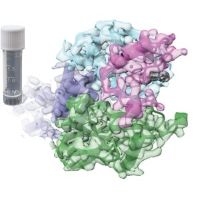Specification
| Organism | Homo sapiens (Human) |
| Expression Host | E.coli |
| Tag Info | C-terminal 6xHis-HPC4-tagged |
| Purity | Greater than 85% by SDS-PAGE |
| Uniprot ID | Q12791 |
| Gene Names | KCNMA1 |
| Alternative Names | BK channel (BKCA alpha) (Calcium-activated potassium channel, subfamily M subunit alpha-1) (K(VCA)alpha) (KCa1.1) (Maxi K channel) (MaxiK) (Slo-alpha) (Slo1) (Slowpoke homolog) (Slo homolog) (hSlo) (KCNMA) (SLO) |
| Expression Region | Partial(411-560aa ) |
| Molecular Weight | 20.0 kDa |
| Protein Sequence | VVCGHITLESVSNFLKDFLHKDRDDVNVEIVFLHNISPNLELEALFKRHFTQVEFYQGSVLNPHDLARVKIESADACLILANKYCADPDAEDASNIMRVISIKNYHPKIRIITQMLQYHNKAHLLNIPSWNWKEGDDAICLAELKLGFIA |
| Form | Liquid or Lyophilization |
| Buffer | The default storage buffer is Tris/PBS-based buffer, 5%-50% glycerol if the delivery form is liquid. The lyophilization buffer is Tris/PBS-based buffer, 6% Trehalose, pH 8.0 if the delivery form is lyophilized powder. Please contact us if you have any special requirment. |
| Reconstitution | Please reconstitute protein in deionized sterile water and we recommend that briefly centrifuge thevial prior to opening the vial .We recommend aliquot for long-term storage at -20℃/-80℃. |
Background
| Relevance | Potassium channel activated by both membrane depolarization or increase in cytosolic Ca2+ that mediates export of K+. It is also activated by the concentration of cytosolic Mg2+. Its activation dampens the excitatory events that elevate the cytosolic Ca2+ concentration and/or depolarize the cell membrane. It therefore contributes to repolarization of the membrane potential. Plays a key role in controlling excitability in a number of systems, such as regulation of the contraction of smooth muscle, the tuning of hair cells in the cochlea, regulation of transmitter release, and innate immunity. In smooth muscles, its activation by high level of Ca2+, caused by ryanodine receptors in the sarcoplasmic reticulum, regulates the membrane potential. In cochlea cells, its number and kinetic properties partly determine the characteristic frequency of each hair cell and thereby helps to establish a tonotopic map. Kinetics of KCNMA1 channels are determined by alternative splicing, phosphorylation status and its combination with modulating beta subunits. Highly sensitive to both iberiotoxin and charybdotoxin. |
| Involvement in Disease | Paroxysmal nonkinesigenic dyskinesia, 3, with or without generalized epilepsy (PNKD3) |
| Subcellular Location | Cell membrane, Multi-pass membrane protein |
| Protein Families | Potassium channel family, Calcium-activated (TC 1.A.1.3) subfamily, KCa1.1/KCNMA1 sub-subfamily |
| Tissue Specificity | KCNMA1 |
QC Data
| Note | Please contact us for QC Data |
| Product Image (Reference Only) |  |

